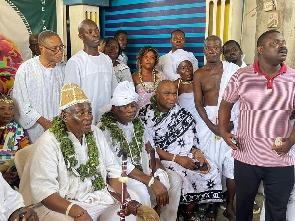 Torgbi Nii Kpambi Vedzesu V and his sub-chiefs partook in the Homowo festival celebration
Torgbi Nii Kpambi Vedzesu V and his sub-chiefs partook in the Homowo festival celebration
Divisional Chief of Aflao-Teshie in the Volta Region, Torgbi Nii Kpambi Vedzesu V has joined his kingsmen in Teshie in Accra, to mark this year's celebration of the Homowo festival.
Torgbi Vedzesu who was recently installed the divisional chief of Teshie-Aflao hails from the Nii Kpambi clan who are originally Gas but have settled in Aflao for centuries.
He was accompanied by some sub-chiefs, elders, and queen mothers from the Aflao Traditional Council.
Torgbi Vedzesu used the opportunity of the festival to reestablish contact with his kingsmen who could not hide their joy seeing their royal son amongst them.
The divisional chief extended felicitations from the Paramount Chief and President of the Aflao Traditional Council, Torgbiga Amenya Fiti V to the people of Teshie and promised the consolidation of the bond of friendship that had existed between the two traditional councils in the years ahead.
A brief history of Teshie:
Teshie is the last of six principal Ga settlements that sprawl the eastern coast of Accra. Ga Mashie, Nungua, La, Osu, and Tema were established before Teshie which is believed to have been founded in the year 1710.
Margaret Field (1940) and Augustus Amarte (1952), recorded that the Teshie Stool is the only Ga stool occupied by an aboriginal Kpeshie family who are custodians of the Kpeshie Lagoon. She recounts that Nii Trebi who was the patriarch of the Kpeshie [Lenshie] family had a ‘village’ on the Teshie site in unbroken continuity from pre-Ga days long before the Nungua Mantse permitted other ‘strangers’ to settle there.
One may ask, how did Teshie come about and who are the people of Teshie?
The people of La lived for about a hundred years around Ajankorte Hill near Abokobi. Between 1600 and 1629, the La they moved en masse to the present location near the coast in pursuit of trading opportunities with Europeans.
Nii Odoi Atsem was the king of La by the beginning of the eighteenth century.
La’s Mankralo then was Nii Okang Nmashie who had riotous and rascally nephews who abused the authority of their uncle. They were spoilsports and went to the extent of stabbing with a dagger anyone who interfered with their amusements.
In the words of the late principal of Prempeh College, Dr. T.A. Osae, a historian and an educationist, “Things came to a head when on the occasion of the celebration of puberty rites for some nieces of King Odoi Atsem, the Mankralo’s wayward nephews excelled their record of rowdyism. Odoi Atsem decided to take firm action once and for all against Nii Okang Nmashie for not restraining his rowdy nephews.
"He was aware Okang Nmashie was powerful and attacking him alone could be disastrous. He thus courted the assistance of the King of Accra who secretly advised Nmashie to quit La before he marched to the support of Odoi Atsem.
Nii Okang Nmashie took heed of the advice and together with his children, his notorious nephews, and a large body of loyal followers, he left La never to return".